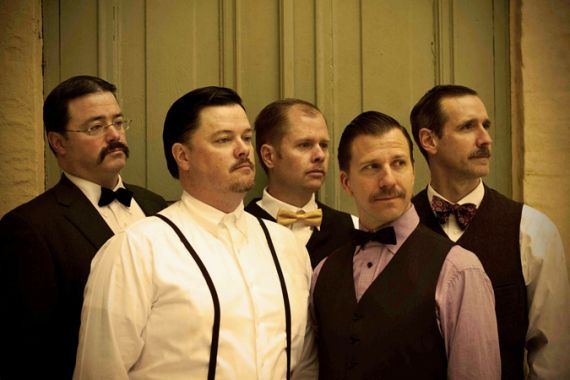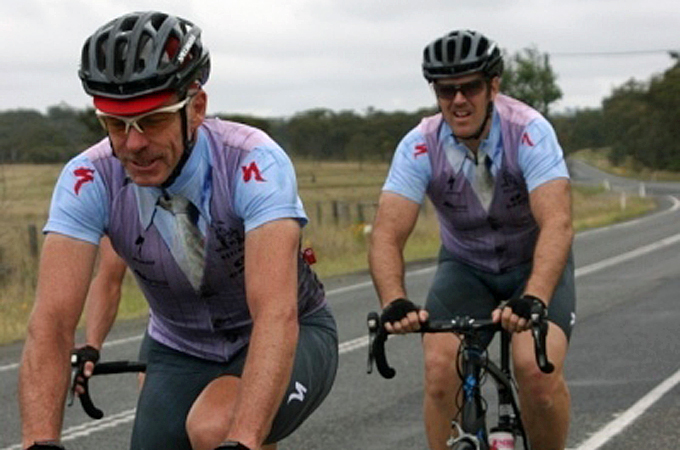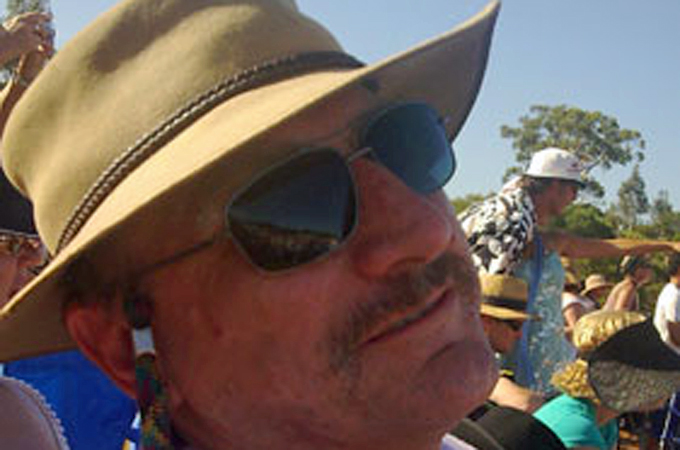The growth of Movember
A look back at the month of real men, real moustaches, talking about real issues and changing the face of men’s health.

| Click through for some of the best photos from the Movember Foundation |
Doha, Qatar – The handlebar. The pencil. The walrus. The soup-strainer. The flap-wings. The flying V. The flavour saver. The wilted cigar. The toothbrush. The falcon perch. The nose-tickler. The Sergeant Pepper.
Whatever you call it, the humble moustache has been in and out of fashion for thousands of years. Not much else unites figures as diverse as Hulk Hogan, John Bolton, Hercule Poirot, Yosemite Sam, Adolf Hitler and Tom Selleck.
Keep reading
list of 4 itemsWoman, seeking loan, wheels corpse into Brazilian bank
UK set to ban tobacco sales for a ‘smoke-free’ generation. Will it work?
Poland lawmakers take steps towards liberalising abortion laws
And each November, hundreds of thousands of men around the globe sport the facial furniture in order to become walking masculine billboards, raising awareness and money for charities such as the UK’s Institute of Cancer Research and the Prostate Cancer Charity, as well as Australia’s Prostate Cancer Foundation and BeyondBlue – Australia’s national depression initiative.
Brett Lehman is one of the 845,000 supporters of “Movember” who have registered their top lip ticklers this year.
|
|
Lehman’s father died from cancer at the age of 54.
“He wasn’t a man of excess. He didn’t smoke. He didn’t drink. He also didn’t see a doctor until it was too late.
“He’s been gone 20 years now, and I still feel sad, knowing that, had he been diagnosed earlier, he might still be here.”
Lehman, an Australian cyclist, says that men often make excuses not to see a doctor.
“We go through stages in life when our priorities maybe aren’t what they should be. Why do we think that attending a meeting or working overtime is more important than our health?”
In the UK, prostate cancer is the most common male cancer, where it will be diagnosed in one of every nine men. More than 100 men each day find out they have the disease, while more than 10,000 die from it each year – in Britain alone.
In the US, the cancer strikes one in every six men.
The Movember project concentrates on the month of November, much as Breast Cancer Awareness Month focuses on October, with participants sponsored to “grow a mo” and take part in other fundraising activities. “Through the power of the moustache”, some $72 million was raised during 2010’s campaign, making Movember the largest non-government funder of prostate cancer research in the world, said Movember co-founder Adam Garone.
|
|
Bristling with enthusiasm
The “rules” state that every participant begins the month clean-shaven, and grows a moustache for the following 30 days – and celebrities and sports personalities have been getting in on the action.
“Movember is a great idea and a lot of fun,” said Thomas Sorensen, goalkeeper for Stoke’s and Denmark’s football teams. “I’m delighted Movember has launched in Denmark – I’ll be growing a ‘mo’ and hoping my fellow Danes will be joining me in raising awareness and funds for men’s health.”
World champion 5,000m runner Mo Farah also let his moustache “go wild” for the month, and encouraged men to carry out self-examinations to notice symptoms of testicular cancer early on.
“If growing a ‘Mo’ can help start just a conversation about men’s health and getting guys to check themselves, or even better, getting their partner to check them, then we should all be doing Movember.”
He said he looked to a certain 1980s British track and field star for inspiration.
“Daley Thompson had one of the greatest moustaches of all time, and he was a true hero, so if it works for Daley, maybe it will inspire some more British athletes.
“Hopefully we can help change the face of men’s health. Best of luck to all you ‘Mo bros’ out there. Don’t forget, every time you shave, a moustache dies.”
|
|
The risks
More than 8,000 men in the United States are found to have testicular cancer each year. The good news is that the disease is often curable – even at an advanced stage.
“Fortunately, 95 per cent of men who are diagnosed with testicular cancer will be cured,” Larry Einhorn MD, Lance Armstrong’s oncologist, told the American Society of Clinical Oncology.
Over his lifetime, a man’s risk of testicular cancer is about one in 250, but it is the most common cancer in males aged 15-44. Prominent symptoms include pain, swelling or lumps on or around the testicles, while those men treated as infants for undescended testes (cryptorchidism), or those with past infertility issues or a family history of the disease are most at risk of contracting it.
Men aged 25-45 are most at risk of developing testicular cancer, Harvard’s Professor Philip Kantoff told Al Jazeera. And while prostate cancer mostly affects men aged 50 and above, they are more at risk if they have a family history of the disease.
Tony Dennis is 53 years old and a prostate cancer survivor.
“This is a different outcome to my father and uncle,” he said.
“My 48-year-old brother has only just begun his journey, post-prostatectomy. And as for my two teenage sons, this family history will sit in the back of their minds for decades to come.
“I had regular PSA checks [the prostate-specific antigen blood test] from the age of 40. I realised that there was a reasonable chance that I may develop prostate cancer, but believed that I wouldn’t die from it. These regular check-ups would ensure that the cancer would be detected early. This turned out to be true. At age 50, the surgery was done and the cancer removed. However, I was totally unaware of the consequences once that initial diagnosis was made. The ongoing incontinence and impotence were overwhelming as they bring life’s pleasures to a complete and sudden stop.
|
|
“To me, Movember is there to generate awareness of the help that is available. It is there to encourage an ever-growing body of research and personal experience that can help us all.
“As for me, at the moment, I’m feeling happy and content that I, with the support and love of my beautiful wife, have a long and happy future ahead of me. At the end of last year, I underwent ‘corrective surgery’ which successfully corrected the incontinence and given me my mojo back. Also, thanks to the continuing work of Movember, in their push for awareness and research, I believe that my boys, and their sons, will also have happy and fulfilled lives.”
Cancer expert Dr Christopher Sweeney told Al Jazeera that there was no proven strategy for preventing the development of prostate cancer.
|
Guide to checking yourself for testicular cancer – Have a bath or a shower. The warm water relaxes the skin of the scrotum and allows any anomalies to be more easily recognised – If possible, stand in front of a mirror to check for any obvious swelling – Support your scrotum with the palm of one hand and use the other to become acquainted with the size, texture and weight of each testicle – In turn, gently roll each testicle between your thumb and forefinger and feel for any lumps or swellings on the surface. It should feel firm and smooth – Don’t be alarmed if one feels slightly larger than the other, this is perfectly normal – Cancerous lumps are most common on the sides of the testicle, but can also show up on the front. The bumpy-feeling duct at the back of your testicles is the epididymis, which carries sperm to the penis – If you find a lump, notice a feeling of heaviness in the scrotum or pain in a testicle, it may not be cancer – but get it checked out by your doctor immediately Source: The Testicular Cancer Resource Centre / Andrology Australia |
“At this stage, the best approach is a healthy heart diet with regular exercise – what is good to prevent heart disease is also good to prevent diabetes and may also help prevent cancer.”
Dr Sweeney is an associate professor at the Dana Farber Cancer Institute, an affiliate of Harvard Medical School. He said that, if there is a family history of prostate cancer, men in their 40s should go to their doctor annually for prostate cancer tests. Without a family history, visits should begin aged 50.
“Check-ups should consistent of an annual prostate examination by finger palpation. The role of PSA testing is controversial and the patient should discuss the risk and benefits with their doctor – as sometime a non-dangerous prostate cancer is found, which may lead to treatment with side effects and no benefits.
“In cases of low grade prostate cancer, some patients can undergo surveillance [instead of surgery]. This area is the subject of active research. Aggressive cancers in young men, however, are curable if treated early. They are the cancers we try to find at check-ups.”
The growing movement
The campaign officially began in Australia in 2003 (though there have been reports of moustache-based charity drives since 1999), with a group of 30 men. Since then, campaign ambassadors have combed the continents to raise the project’s profile.
Movember got its US launch five years ago, and today there are official campaigns running in the UK, Ireland, the US, Canada, New Zealand, Australia, South Africa, Finland, Denmark, Norway, Belgium, the Netherlands, the Czech Republic and Spain.
Australian airline Qantas has even joined the charity’s corporate sponsors, decorating one of their planes with a go-faster ‘tash.
The project has not been without its critics, however, and has faced claims that high running costs and overheads undermine activists’ fundraising efforts. But spokesmen for the Movember Foundation say that administration costs are around eight per cent of funds raised, “which is low by international standards – best practice recommendations are in the range of 15 to 25 per cent”.
This year’s campaign has already broken records, before all the funds are counted, with $79.5 million raised globally during the month (up from last year’s total of $72 million).
The $79.5 million is only an interim figure, however, as sponsor money continues to flow in. What’s more, many moustachioed activists grow somewhat attached to their face-locks as the weeks pass – and relatives, friends, wives and girlfriends often end up fronting up yet more cash in efforts to persuade their hairy loved ones to shave again, come December.
As Mo Farah alluded, during the rest of the year, the fuzzy facewarmer is less fashionable in western countries than it once was, and so the sporting of facial hair also inspires questions from complete strangers.
|
|
“It’s hard to believe what began as a bit of a joke has turned into a global movement for men’s health,” said Movember co-founder Adam Garone.
“It’s humbling to see so many men and women passionately support this cause. These days you can’t grow a moustache without people asking what’s going on, leading to amazing conversations about cancers that affect men … [But] there is much work to do. With more than 240,000 new cases of prostate cancer expected this year, the need for new collaborative research is more urgent than ever.”
But one “mo bro” really went the extra mile (or should that be “the extra 1,000 miles”?) this year. In memory of his father, cyclist Brett Lehman pedalled his way from Brisbane to Melbourne – a 14-day marathon effort over 1,700 km – raising more than $27,000, and advocating for men’s health along the way.
“I hope that by participating in Movember, I might be able to convince someone to re-assess their health priorities, and maybe change them. Getting fit, eating the right foods, all help – but they only go part of the way in protecting us from cancer. Having a routine check-up and talking to your doctors seems such a small price to pay to live a longer life.
“I hope we can get someone’s father to see a doctor.”
Follow James Brownsell on Twitter (and see how his own moustache-growing attempt went): @JamesBrownsell
 Cyclist Brett Lehman (l) raised $27,000 with a 1,000-mile bike ride from Brisbane to Melbourne [Movember Foundation]
Cyclist Brett Lehman (l) raised $27,000 with a 1,000-mile bike ride from Brisbane to Melbourne [Movember Foundation] Guitarist (and famed moustache wearer) Frank Zappa, who recorded more than 60 albums, died from prostate cancer in 1993 [CC/
Guitarist (and famed moustache wearer) Frank Zappa, who recorded more than 60 albums, died from prostate cancer in 1993 [CC/
 Prostate cancer survivor Tony Dennis joined the Movember campaign after his father and uncle died from the disease, while his brother is currently fighting it
Prostate cancer survivor Tony Dennis joined the Movember campaign after his father and uncle died from the disease, while his brother is currently fighting it The Qantas ‘Mo’ jumbo jet [Movember Foundation]
The Qantas ‘Mo’ jumbo jet [Movember Foundation]